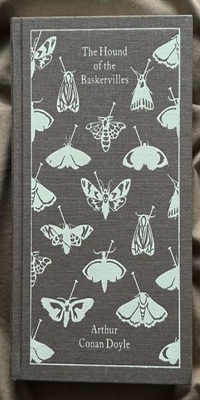The Hound of the Baskervilles: Summary, Plot, Characters, Literary Analysis & More
“The Hound of the Baskervilles,” penned by the renowned author Arthur Conan Doyle, made its debut in the literary world and captivated readers in 1901.
This detective novel stands as one of Conan Doyle’s most celebrated works, boasting both critical acclaim and widespread popularity.
The narrative revolves around the legendary detective Sherlock Holmes and his trusty companion Dr. John Watson, who become entwined in a perplexing case concerning the eerie Baskerville family.
Set against the backdrop of the atmospheric Baskerville Hall and the fog-draped moors, the story delves into themes of ancestral legacies, enigmatic deaths, and the interplay of light and shadow in unraveling a sinister mystery.

The story delves into themes of ancestral legacies, enigmatic deaths, and the interplay of light and shadow in unraveling a sinister mystery.
Table of Contents
Summary The Plot Characters Key Themes Genres Language used Literary devices Summing upThe Plot
In “The Hound of the Baskervilles,” the perplexing tale commences with the death of Sir Charles Baskerville, rumored to have been claimed by a phantom hound on the grounds of Baskerville Hall.
Dr. James Mortimer enlists Sherlock Holmes and Dr. John Watson’s aid to unravel the sinister circumstances.
The focus shifts to Sir Henry Baskerville, the sole heir, as he inherits the family estate and becomes embroiled in the ominous legend.
Amidst the eerie moors and the ancestral mansion, Holmes and Watson untangle a web of deceit, discovering that reality is far more treacherous than myth.
Characters
From the astute and methodical Sherlock Holmes to the enigmatic and tormented Sir Henry Baskerville, each character plays a crucial role in unraveling the chilling mystery that shrouds Baskerville Hall.
In this section, we provide a summary of these characters.
Sherlock Holmes
The brilliant detective Sherlock Holmes employs his keen intellect and astute observation to tackle the enigmatic case of the Baskervilles, unveiling hidden truths beneath the surface.
Dr. John Watson
As the steadfast companion of Holmes, Dr. Watson narrates the tale, navigating the eerie moors and unraveling the dark secrets surrounding the Baskerville family.
Sir Charles Baskerville
The late owner of Baskerville Hall, Sir Charles Baskerville’s mysterious death sets the stage for the haunting events that follow.
Sir Henry Baskerville
The new heir to the Baskerville estate, Sir Henry’s arrival introduces an element of uncertainty as he grapples with the sinister legend that shrouds his family.
Dr. James Mortimer
A friend of the Baskervilles and a man of science, Dr. Mortimer seeks Holmes’ expertise to uncover the truth behind Sir Charles’s death.
Laura Lyons
A woman entangled in the web of the Baskerville mystery, Laura Lyons’s connection to the case remains shrouded in ambiguity.
Jack Stapleton
An enigmatic figure living near the moors, Stapleton’s presence raises suspicion as his motives and past are brought into question.
Rodger Baskerville
The ancestor who initiated the Baskerville curse, Rodger’s tale adds a historical layer to the unfolding events.
Beryl Stapleton
Mysterious and alluring, Beryl’s role in the narrative becomes intertwined with the unraveling secrets of the Baskerville family.
Hugo Baskerville
The originator of the hound legend, Hugo’s dark deeds cast a long shadow over his descendants.
Barrymore
The butler at Baskerville Hall, Barrymore’s loyalty to the family is evident, yet he holds secrets that contribute to the suspenseful atmosphere.
Mrs. Barrymore
Wife of Barrymore, Mrs. Barrymore’s anxious demeanor hints at her own involvement in the mysteries of the estate.
Key Themes
Amidst the mist-laden moors and dark corridors of Baskerville Hall, “The Hound of the Baskervilles” explores mutiple themes, including superstition, fear and mystery, and ancestral legacy, amongst others.
Below, we provide a summary of the multiple themes found in this story.
Superstition and Rationalism
The clash between superstition and rationalism is evident throughout the novel.
The legend of the spectral hound that haunts the Baskerville family is rooted in local folklore and superstition.
Sherlock Holmes, embodying rationalism, seeks to unravel the mystery behind the legend by applying logical deduction and scientific methods.
Fear and Mystery
The theme of fear is palpable, with the legend of the hound instilling terror in the characters and the reader alike.
The novel builds an atmosphere of mystery and suspense as characters grapple with the fear of the unknown, the supernatural, and the dangers of the desolate moorland.
Inheritance and Legacy
The curse that supposedly plagues the Baskerville family serves as a symbol of the weight of inheritance and legacy.
The burden of the past, whether in terms of wealth, reputation, or responsibilities, influences the characters’ decisions and actions.
Class and Social Divisions
The novel portrays the social divisions and hierarchies of early 20th-century England.
The Baskervilles, representing the aristocracy, and the local inhabitants, including the Stapletons, who depend on their patronage, highlight the contrasts between different social classes.
Deception and Secrecy
Deception and secrecy are recurring motifs as characters hide their true intentions or identities. The mystery’s resolution involves uncovering hidden motives and untangling the web of lies.
Genres in The Hound of the Baskervilles
“The Hound of the Baskervilles” seamlessly blends the elements of detective fiction and Gothic mystery.
As Sherlock Holmes employs his analytical prowess to solve the perplexing case, the story takes on the characteristics of a detective narrative.
Simultaneously, the eerie atmosphere, ancient legends, and haunted landscapes align with the conventions of Gothic fiction, heightening the suspense and creating an engaging amalgamation of genres.
“The Hound of the Baskervilles” by Sir Arthur Conan Doyle incorporates elements of both detective fiction and Gothic mystery, blending these genres to create a captivating and atmospheric narrative.
Detective Fiction
The novel is a quintessential example of detective fiction, with Sherlock Holmes at the forefront of solving the enigmatic case.
Key characteristics of this genre include:
- Investigation and Deduction: Sherlock Holmes employs his renowned powers of deduction and observation to solve the mystery surrounding the death of Sir Charles Baskerville. He meticulously pieces together evidence, scrutinizes details, and forms logical conclusions.
- Logic and Reasoning: Holmes’s approach is grounded in logical reasoning and scientific methods. He emphasizes the importance of evidence and is skeptical of supernatural explanations, reflecting the analytical nature of detective fiction.
- Unveiling the Truth: The narrative is structured around the gradual revelation of clues, red herrings, and the eventual unveiling of the truth behind the mysterious occurrences. Holmes’s detective work leads to the resolution of the case.
Gothic Mystery
The novel also incorporates elements of Gothic mystery, drawing on the eerie and atmospheric qualities of this genre:
- Atmosphere of Suspense: The setting of the Baskerville Hall on the fog-shrouded moorland contributes to an eerie and suspenseful atmosphere. The supernatural legend of the hound adds a sense of dread and mystery.
- Mysterious and Haunting Elements: The spectral hound serves as a Gothic motif, embodying the mystery and terror often associated with the genre. The theme of ancestral curses and family secrets adds layers of intrigue.
- Isolated and Foreboding Settings: The isolation of the moorland and the eerie landscapes of Grimpen Mire and the Great Grimpen Mire contribute to the Gothic ambiance. These settings mirror the traditional isolated and sinister environments of Gothic fiction.
- Emotional Intensity: The emotional turmoil experienced by characters, such as Sir Henry Baskerville and Laura Lyons, adds depth to the narrative and aligns with the emotional intensity characteristic of Gothic literature.
The blend of detective fiction and Gothic mystery genres enhances the complexity of the narrative.
Sherlock Holmes’s deductive prowess and the suspenseful, haunting atmosphere of the moorland and Baskerville Hall merge to create a story that engages readers with its intricate mystery while evoking a sense of tension, unease, and intrigue.
Language used in The Hound of the Baskervilles
Arthur Conan Doyle masterfully wields language to evoke the ominous atmosphere of the moors and the tension surrounding the Baskerville legend.
Through Dr. John Watson’s narrative voice, readers are immersed in the emotions of fear and curiosity.
Holmes’ inquiries and conversations with Watson, such as when he asks Watson about his observations or reveals his deductions, deepen the connection between characters and readers, intensifying the story’s impact.
Literary devices in The Hound of the Baskervilles
In the book, Arthur Conan Doyle employs a myriad of literary devices to craft an immersive narrative.
Through the dynamic between Holmes and Doctor John Watson, Doyle employs dialogue not only for plot progression but also to reveal character traits.
The use of foreshadowing, like when they lure Sir Charles Baskerville, heightens the sense of anticipation and foreboding.
The description of Sir Henry’s clothes subtly conveys information about his character and circumstances, enriching the storytelling.
Similes
When Holmes tells Sir Henry about the hound’s legend, he likens it to “the devil hound,” immediately conjuring an image of terror and malevolence.
Holmes’ comparison enhances the eerie aura, making the supernatural aspect more palpable and engaging the reader’s imagination.
Metaphors
Conan Doyle’s use of metaphors infuses depth into “The Hound of the Baskervilles.”
When Holmes asks Watson to be vigilant, comparing Watson to a faithful watchdog, it encapsulates Watson’s role in safeguarding Sir Henry.
As Sir Henry arrives and walks home, his journey becomes a metaphor for his confrontation with his family’s legacy, echoing his transition from outsider to inheritor, and symbolizing his eventual acceptance of the truth.
Analogies
The book employs analogies to illuminate intricate concepts. As Sir Henry walks home, his journey parallels his psychological expedition into the depths of his family’s history.
Watson’s encounters are akin to the unraveling of the threads of the Baskerville mystery, each interaction slowly exposing the layers of intrigue that have shaped Sir Henry’s life.
Imagery
From the haunting image of Sir Charles’ death on the moor to the scent of Sir Henry lingering in the hallways, readers are immersed in the sights, sounds, and smells of the story.
These sensory details enrich the narrative, making the settings and characters more tangible and evoking a deeper emotional connection.
Symbolism
People and figures that Watson encounters serve as symbolic intersections with the overarching mystery, representing the unfolding layers of the plot.
The “Baskerville fortune” acts as a symbol of the family’s legacy, carrying both material wealth and the weight of their ancestral past.
Sir Henry’s scent embodies a trace of identity, signifying his presence and connection to the estate.
As Sir Henry leaves, his departure symbolizes his transition, marked by growth and the journey towards self-discovery.
Personification
Instances of personification in the book lend life-like qualities to inanimate objects and natural elements. Just as Holmes shoots sharp glances that pierce through mysteries, the descriptive prose personifies the characters’ actions.
Watson’s keen observation is reflected when he notices minute details, making the narrative vivid. Watson’s learning journey symbolizes growth as he learns about the Baskerville legacy, while the eerie howling wind becomes a character in itself, heard only by him.
Hyperbole
Hyperbole in “The Hound of the Baskervilles” heightens suspense and emotions.
As Holmes remarks, his astute observations may be amplified to emphasize his analytical brilliance.
When Holmes reveals secrets, the revelations may be exaggerated to magnify their impact.
Hyperbolic descriptions of the moor and Stapleton’s house intensify their ominous nature, evoking a sense of dread.
The exaggerated traits of Barrymore’s brother add layers to his mysterious character, enhancing the intrigue.
Irony
Various forms of irony interplay to deepen the narrative. Watson notices the contrast between the serene moors and the ominous atmosphere they conceal, creating situational irony.
As Watson learns about Sir Charles’s will, the dichotomy between his intentions and the perceived curse adds dramatic irony.
The subdued sounds of Baskerville Hall juxtaposed with the echo of the howling hound constitute auditory irony, highlighting the mysterious tension.
Juxtaposition
As Watson begins his exploration, the serene countryside is sharply contrasted with the impending suspense. Watson reports the eerie legends amid the tranquility of the moors, creating an unsettling dichotomy.
Holmes’ deductive prowess is showcased as he investigates the inexplicable, illuminating the disparity between logic and the supernatural.
The juxtaposition of the escaped convict’s tales of adventure in South America adds a paradoxical layer to the otherwise gothic setting.
Paradox
Doyle employs paradoxes to engage readers. Holmes’ uncanny ability to unravel mysteries often seems paradoxically supernatural for a country doctor.
As Holmes predicts the outcome with precision, the uncertainty paradoxically reinforces his reputation.
The young man’s decision to leave Baskerville Hall for safety becomes a paradox as it swaps presumed sanctuaries. These paradoxes spark reflection on the unforeseen twists within a seemingly straightforward narrative.
Allusion
Allusions enrich the narrative. When Stapleton arrives, his character echoes the uncanny atmosphere of the moors, reminiscent of the eerie bearded man in the tale.
Holmes’ agreement with Stapleton forms a parallel with his recognition of the lurking dangers, much like the hidden peril of the vicious hound.
The reference to the brown boots hints at deeper secrets, akin to the mysteries they conceal.
Allegory
While not overtly allegorical, “The Hound of the Baskervilles” contains elements that can symbolize broader themes. The gigantic hound symbolizes primal fears and ancestral curses, embodying the family’s dark legacy.
The bearded man embodies the sinister elements of human nature lurking beneath the surface. Watson’s encounter (when Watson sees a mysterious figure standing alone up in the hills) with the bearded figure mirrors his journey to uncover hidden truths.
As the walking stick aids Sir Henry’s journey, it also reflects his quest for self-discovery, much like the ordeal of facing the hellish hound.
The Use of Dialogue
In “The Hound of the Baskervilles,” dialogue serves as a potent tool for character development and thematic exploration.
As Watson investigates, his conversations unveil his curiosity and determination, highlighting his role as a diligent investigator.
When Holmes ties together seemingly unrelated clues through dialogue, his deductive prowess is vividly showcased.
The interactions with the escaped convict reflect themes of justice and society’s impact on individuals. Holmes’ dialogues also reveal his brilliant deductions, showcasing his analytical mind.
Parallelism
Parallelism subtly shapes the structure of “The Hound of the Baskervilles,” enhancing its impact.
As Watson hears the echoes of the hound’s howl across the moors, it mirrors the recurring themes of ancestral legacy and fate.
The repeated encounters with the young man and the mysterious sounds evoke a sense of parallel experiences, intertwining the lives of various characters.
This literary device underscores the interconnectedness of events and characters, amplifying the story’s depth.
Rhetorical Devices
Watson’s contemplative thoughts in the bustling city of London employ rhetorical questions, engaging readers in his introspection.
Both Watson and Holmes employ parallelism when describing observations, adding rhythmic impact.
By utilizing these devices, Doyle elevates the narrative’s persuasion, coaxing readers to delve deeper into the enigmatic tale.
The Hound of the Baskervilles: FAQs
Delve into these frequently asked questions to unravel the enigma surrounding Arthur Conan Doyle’s iconic detective novel.
What is The Hound of the Baskervilles about summary?
“The Hound of the Baskervilles” follows detective Sherlock Holmes and Dr. John Watson as they investigate the mysterious death of Sir Charles Baskerville. The family’s history is marred by a legend of a supernatural hound that brings death to its heirs. Holmes unravels the case, revealing a web of deception involving greed and revenge. The story explores the tension between rationality and superstition.
What is the main point of The Hound of the Baskervilles?
The main point of “The Hound of the Baskervilles” is the resolution of a perplexing mystery surrounding the death of Sir Charles Baskerville. As Sherlock Holmes uses logic and deduction to untangle the clues, the narrative examines themes of fear, superstition, and the power of scientific inquiry in dispelling myths.
What happens at the end of The Hound of the Baskervilles?
At the end of the novel, Sherlock Holmes reveals that the hound responsible for the deaths is not supernatural but rather a trained animal used by Stapleton to eliminate potential heirs to the Baskerville fortune. The truth behind the legend is unveiled, and the criminal is apprehended, restoring safety to the Baskerville family.
What is the moral lesson of The Hound of the Baskervilles?
The moral lesson of “The Hound of the Baskervilles” lies in the conflict between reason and superstition. The novel emphasizes the importance of using logic and evidence-based investigation to debunk myths and solve mysteries. It highlights how fear and irrational beliefs can lead to misguided actions and manipulations.
What makes the moor setting significant in the story?
The eerie moors serve as a powerful backdrop, adding an atmospheric and mysterious layer to the narrative, reflecting the supernatural themes of the tale.
Are there supernatural elements in the story?
While the plot revolves around a legendary hound, the novel ultimately offers rational explanations for seemingly supernatural occurrences, aligning with Holmes’ logical approach.
How does the relationship between Holmes and Watson contribute to the story?
Holmes and Watson’s partnership embodies the essence of deduction and camaraderie. Their dynamic allows readers to experience the case through Watson’s eyes while marveling at Holmes’ analytical prowess.
Are there adaptations of “The Hound of the Baskervilles” in other media?
Yes, the novel has been adapted into various films, TV series, and stage productions, showcasing its enduring appeal and cultural impact over the years.
Summing up: The Hound of the Baskervilles: Summary, Plot & More
As you now know from this “The Hound of the Baskervilles” summary, this work stands as a timeless testament to Arthur Conan Doyle’s mastery of storytelling.
Its intricate web of mysteries, vivid characters, and richly atmospheric settings weave a narrative that transcends its time, continuing to captivate readers across generations.
Through the unyielding partnership of Sherlock Holmes and Watson, the enigma of the Baskerville curse comes alive, underscored by themes of legacy, fear, and the relentless pursuit of truth.
The clever use of literary devices, from dialogues that uncover character depths to the symbolism that adds layers of meaning, enhances the immersive experience.
With every twist and revelation, the reader is drawn further into the dark corners of the moor and the human psyche.
“The Hound of the Baskervilles” remains an enduring classic that not only thrills with its mystery but also resonates with its exploration of human nature and the interplay of the past and present.
Other Notable Works by Arthur Conan Doyle
If you are interested in The Hound of the Baskervilles, you may be interested in other works by The Hound of the Baskervilles including:
- “Sherlock Holmes Series“: Arthur Conan Doyle’s iconic detective series features numerous captivating adventures of Sherlock Holmes and Dr. John Watson. From “A Study in Scarlet” to “The Adventures of Sherlock Holmes,” these stories showcase Holmes’ unparalleled deductive skills and Watson’s loyal companionship, offering a rich tapestry of mysteries.
- “The Sign of Four“: This novel continues the Sherlock Holmes saga, where the duo unravels a complex case involving a stolen treasure, a mysterious pact, and a journey into the heart of colonial India. The story combines intricate plotting with the chemistry between Holmes and Watson.
- “The Lost World“: Departing from his detective tales, Conan Doyle ventures into the realm of adventure and science fiction. In this novel, a daring expedition uncovers a prehistoric world hidden in the South American jungle, introducing readers to dinosaurs and unknown dangers.
- “Professor Challenger Series“: This series features the boisterous Professor George Edward Challenger, a brilliant and eccentric scientist. “The Lost World” is the first entry, followed by “The Poison Belt,” “The Land of Mist,” and “When the World Screamed.”
- “The White Company“: Transporting readers to the medieval era, this historical novel follows a young archer named Alleyne Edricson during the Hundred Years’ War. It offers a blend of adventure, chivalry, and intricate character development.
Arthur Conan Doyle’s extensive bibliography spans various genres, showcasing his versatility as a storyteller and his ability to create engaging narratives that continue to captivate readers worldwide.







